Positive Health Online
Your Country

Changes in Self-Reported Pain Scores Following a Single EMMETT Technique Treatment
listed in bodywork, originally published in issue 267 - January 2021
What is the EMMETT Technique?
The EMMETT Technique is a unique complementary therapy that works to relax the body and mind, to ease discomfort and increase ranges of movement. It was created by Ross Emmett who is an exceptionally gifted therapist based in Queensland, Australia who has worked with many physicians and surgeons to assist their patients’ recoveries. He has developed the technique over 30 years of clinical experience and this therapy has now been shared all over the world, including in the UK. Training seminars are held in various localities all over the country and the courses are accredited by Complementary Health Professionals – one of the UKs leading professional associations.
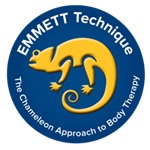
EMMETT practitioners are frequently viewed as’“fixers’ of discomfort and ’restorers’ of movement and balance. Clients come for complementary therapy for a number of reasons and through a holistic approach, EMMETT practitioners are guided by the specific needs of the individual client at that particular time, through assessment, observation and discussion to treat each person individually. Set sequences are not used because EMMETT practitioners recognize that every individual is different and treatments tailored to those individual needs are more effective. In fact, this therapy applauds its ‘chameleon approach’ to treatment in that is can be so well tailored to treat the specific needs of the individual. The technique uses the application of light pressure at specific points on the body that enable muscle groups to gently release and relax. Most people report a positive change with the concerns they came with and typical responses they experience are:
- Improved comfort within the area treated;
- A sense of being ‘more grounded’;
- Improved balance;
- A greater range of movement in the area treated;
- More restful sleep;
- Enhanced mood;
- A sense of lightness within their body.
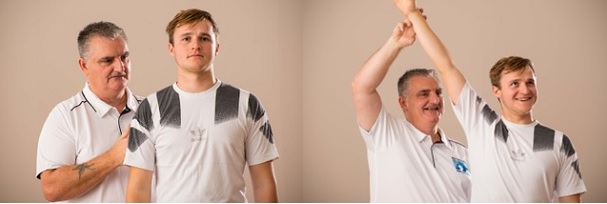
Treatments are usually carried out with the client wearing light, comfortable clothing. Some practitioners treat clients in a clinic setting but the therapy can also be delivered in people’s homes, with the client sitting or standing. Often a treatment is relatively short as it does not take a long time to achieve a positive change and results are usually immediate. EMMETT practitioners do not prescribe courses of treatments – often one treatment is all that is needed for assisting acute issues. Maintenance treatments for relaxation, to prevent issues occurring and to maintain a state of equilibrium in the body are also available. It is important to stress that the EMMETT Technique does not claim to treat illnesses, diseases, syndromes or medical conditions. The technique assists with the discomfort and limitations that arise from conditions, trauma or restrictions. Each person is unique and has their own individual responses. EMMETT therapy does not intend to replace or substitute any medical advice or treatment. It is recommended that clients consult their GP about any health concerns they may have.
Outline of Research Undertaken
In order to prove that the EMMETT Technique does what is claimed by Ross Emmett and the thousands of practitioners worldwide, it was decided that a project should take place within a hospital environment on medical and ancillary staff as these individuals are often quite skeptical and would be very honest about their results. So, 58 staff members at a London teaching hospital were offered 15-minute treatments using the EMMETT Technique to assist with general muscular pain and discomfort. All participants reported a significant improvement following treatment. Results showed that treatment using the EMMETT Technique created statistically significant reduction in pain and that the magnitude of the positive change was very large.
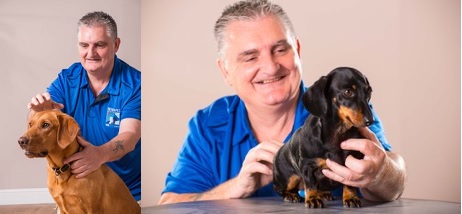
Author’s Background
Tony Sherry MCHP was a Registered General Nurse for 28 years and specialized in Adult Intensive Care at Guy’s and St Thomas’ NHS Foundation Trust where he worked for the last 21 years of his career. Prior to retiring in 2016, I spent 17 years as the Research Matron for Critical Care, anaesthetics and Acute and Chronic Pain. As part of Tony’s NHS retirement plan, he retrained as a complementary therapist using the EMMETT Technique, as he had found from his own personal experience that this therapy proved more effective than others at giving me quick relief from pain and returning normal function following a severe back injury. However, as a Research Nurse he was also aware that like many other physical therapies, the effectiveness of the treatment was only captured in anecdotal reports with little critical evaluation of the impact of treatment. He was also aware that without this evidence, the Advertising Standards Agency does not permit claims about the EMMETT Technique’s relieving pain to be made in any literature or promotional material, even though all of his clients self-reported an improvement. Therefore, he sought approval within the Guys and St Thomas’s Critical Care Services, to carry out an evaluation after offering EMMETT Treatments in the workplace for any staff who self-referred with muscular pain or discomfort.
Setting
The setting for this evaluation was within a busy Department of Critical Care and Anaesthetics in a major London teaching Hospital. He had been granted permission from the department management to be able offer EMMETT Technique sessions to the staff over a three-month period for the purpose of this study. The sessions were offered as part of the Trust’s Improving Staff Health and Wellbeing programme.
Method
The author emailed the entire department which consisted of approximately 1200 staff members from many disciplines mainly Nurses, Doctor’s, Technicians and Ancillary Staff. In the email he gave the background to the technique and offered a free 15-minute appointment. The appointments took place in his office and were aimed at addressing the staff members’ pain and discomfort. He also treated a few clients during the weekends and they gave permission to include their data in this evaluation. One staff member was contacted who had been on sick leave for several months with a chronic back injury.
58 staff members participated in this evaluation between April to June 2016. He started the appointments with a discussion about the background of the technique and gained verbal consent from the staff members to use the technique to help with their issue. He documented data points of name, age, sex, occupation, and a pain rating score of 0 to 10 (0 being no discomfort and 10 a severe interruption to daily life) to see how problematic their issues were before and after treatment. All documentation and appointments were completed by the author. All of the data was collected during this initial visit. All sessions took no longer than 15 minutes to complete from walking through the door to the appointment being completed. All sessions were carried out with the staff member either seated or standing. All participants were offered a follow up appointment should they require one. Only 2 people felt this was needed and both of those participants actually returned with different issues that they wanted help with.
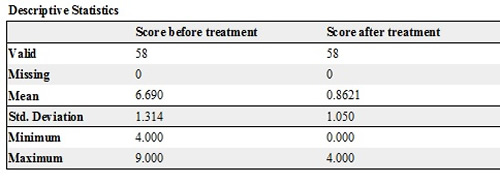
Results
There were 58 participants in this study - 38 Females and 20 Males.
Nurses made up the largest group (n=24) and Lower Back Pain was the biggest issue (n=15).
Pain scores pre-treatment ranged from 4/10 to 9/10. 95% (n=55) rated their pain score at 5/10 or higher pre=treatment and 34% (n=20) rated their pain at 8/10 or higher pre-treatment.
All participants reported a reduction in pain following a singe treatment with the post-treatment scores ranging from 0/10 to 4/10.
52% reported being pain free following treatment (n=30). The mean pre-treatment score was 6.7 and the mean post treatment score was 0.9.
Staff members reported they felt a difference within seconds.

Analysis of the data with a ‘Paired T-Test’ (a test usually used to compare before and after results) show that there is statistical difference between the level of reported pain before an EMMETT session and after an EMMETT session (p<0.001), indicating that the two scores are not random changes, or errors in measurement.
How impressive the change was is reflected in the Cohen’s d score of 4.046 - the positive change in scores following the EMMETT session were very large. (See Appendix)
The largest group within the data was the people with Lower Back pain (n=15). The data from this group was very similar to the total group data, i.e. p-value of <0.001 and a Cohen’s d of 3.63 - a very large effect size.
One staff member who had been on long term sick leave with chronic back pain and self-reported a dramatic reduction on her pain following treatment, was seen by Occupational Health one week after treatment and assessed as being fit to return to work.
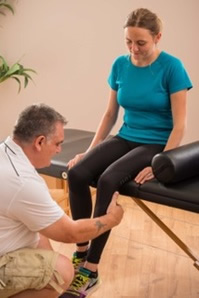
Conclusion
This study has proven that the EMMETT Technique is a valuable therapy for the treatment of pain and discomfort and has been particularly useful in helping one participant on long-term sick leave return to work. Additionally, as it can be done in the workplace in a short period of time without the need to remove clothing, it is a highly adaptable therapy that can be included in any work setting for the health and wellbeing of staff members. Therefore, it could be a valuable addition to any staff programme for protecting the health and wellbeing of their staff, especially where back and joint pain has been identified as a potential risk to employees. The EMMETT Technique can assist company’s and their staff in reducing sick leave from ongoing back pain.
Appendix
from: McLeod, S. A. (2019, July 10). What does effect size tell you? Simply psychology: https://www.simplypsychology.org/effect-size.html
Statistical significance (p-value) is the least interesting thing about results. You should describe the results in terms of measures of magnitude – not just, does a treatment affect people, but how much does it affect them.
‘Cohen’s d’ is a measure of effect size.
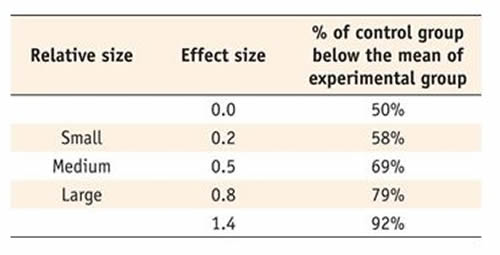
What is Effect Size?
Effect size is a quantitative measure of the magnitude of the experimenter effect. The larger the effect size the stronger the relationship between two variables.
A ‘Cohen’s d’ of 1 indicates the two groups differ by 1 standard deviation, a d of 2 indicates they differ by 2 standard deviations, and so on.
Cohen suggested that d=0.2 be considered a 'small' effect size, 0.5 represents a 'medium' effect size and 0.8 a 'large' effect size. This means that if two groups' means don't differ by 0.2 standard deviations or more, the difference is trivial, even if it is statistically significant.
‘Cohen's d’ is an appropriate effect size for the comparison between two means. It can be used, for example, to accompany the reporting of t-test and ANOVA results. It is also widely used in meta-analysis.
Further Information
For more information about training in the EMMETT Technique in the UK or to find a practitioner, visit www.emmett-uk.co.uk. As well as training for general therapy, there are also additional courses available for treating horses and dogs. To read an excellent published article on the use of EMMETT for dogs from January 2020, visit www.complementaryhealthprofessionals.co.uk/accredited-course-providers and click on the link in the EMMETT Technique for Dogs and Horses section.
The author is a senior international EMMETT Instructor and Advanced EMMETT Practitioner and can be contacted through ECH Therapies – www.echtherapies.co.uk
Comments:
-
No Article Comments available